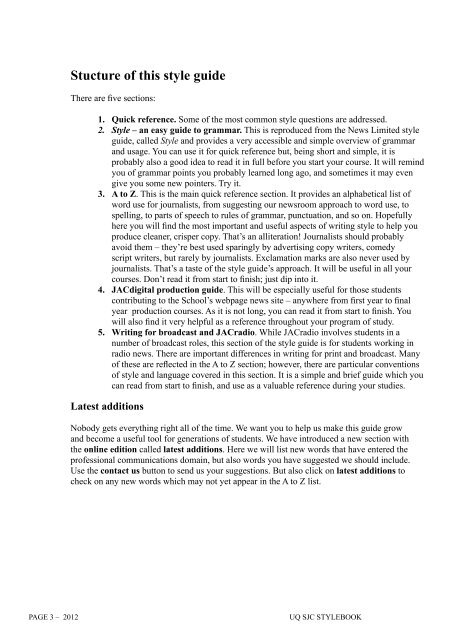You also want an ePaper? Increase the reach of your titles
YUMPU automatically turns print PDFs into web optimized ePapers that Google loves.
Stucture of this <strong>style</strong> <strong>guide</strong>There are five sections:1. Quick reference. Some of the most common <strong>style</strong> questions are addressed.2. Style – an easy <strong>guide</strong> to grammar. This is reproduced from the News Limited <strong>style</strong><strong>guide</strong>, called Style <strong>and</strong> provides a very accessible <strong>and</strong> simple overview of grammar<strong>and</strong> usage. You can use it for quick reference but, being short <strong>and</strong> simple, it isprobably also a good idea to read it in full before you start your course. It will remindyou of grammar points you probably learned long ago, <strong>and</strong> sometimes it may evengive you some new pointers. Try it.3. A to Z. This is the main quick reference section. It provides an alphabetical list ofword use for journalists, from suggesting our newsroom approach to word use, tospelling, to parts of speech to rules of grammar, punctuation, <strong>and</strong> so on. Hopefullyhere you will find the most important <strong>and</strong> useful aspects of writing <strong>style</strong> to help youproduce cleaner, crisper copy. That’s an alliteration! Journalists should probablyavoid them – they’re best used sparingly by advertising copy writers, comedyscript writers, but rarely by journalists. Exclamation marks are also never used byjournalists. That’s a taste of the <strong>style</strong> <strong>guide</strong>’s approach. It will be useful in all yourcourses. Don’t read it from start to finish; just dip into it.4. JACdigital <strong>production</strong> <strong>guide</strong>. This will be especially useful for those studentscontributing to the School’s webpage news site – anywhere from first year to finalyear <strong>production</strong> courses. As it is not long, you can read it from start to finish. Youwill also find it very helpful as a reference throughout your program of study.5. Writing for broadcast <strong>and</strong> JACradio. While JACradio involves students in anumber of broadcast roles, this section of the <strong>style</strong> <strong>guide</strong> is for students working inradio news. There are important differences in writing for print <strong>and</strong> broadcast. Manyof these are reflected in the A to Z section; however, there are particular conventionsof <strong>style</strong> <strong>and</strong> language covered in this section. It is a simple <strong>and</strong> brief <strong>guide</strong> which youcan read from start to finish, <strong>and</strong> use as a valuable reference during your studies.Latest additionsNobody gets everything right all of the time. We want you to help us make this <strong>guide</strong> grow<strong>and</strong> become a useful tool for generations of students. We have introduced a new section withthe online edition called latest additions. Here we will list new words that have entered theprofessional communications domain, but also words you have suggested we should include.Use the contact us button to send us your suggestions. But also click on latest additions tocheck on any new words which may not yet appear in the A to Z list.PAGE 3 – <strong>2012</strong>UQ <strong>SJC</strong> STYLEBOOK


